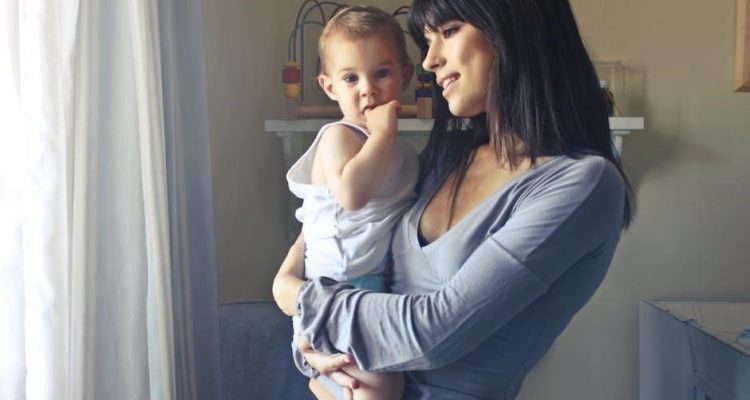Caring for a baby squirrel requires dedication, patience, and proper knowledge to ensure its survival and healthy development. This guide provides essential tips and expert advice.
Understanding the Importance of Proper Care
Proper care is crucial for a baby squirrel’s survival, as improper handling can lead to high mortality rates. Ensuring hydration, nutrition, and warmth are vital to prevent complications like hypothermia and dehydration. Without adequate care, baby squirrels may not develop properly or survive. This emphasizes the need for informed, attentive, and nurturing support during their early stages of life.
Key Considerations for Raising a Baby Squirrel
Raising a baby squirrel involves providing a safe environment, proper feeding, and regular monitoring. Using tools like Pedialyte for hydration and puppy milk replacer for nutrition is essential. Maintaining warmth and stimulating waste elimination are critical. Handling gently and minimizing stress helps promote healthy development. These steps ensure the squirrel grows strong and prepared for eventual release into the wild.
Determining If It’s a Baby Squirrel
Identify baby squirrels by their small size, pink skin, and lack of fur. They make high-pitched squeaks and rely on their mother for warmth and care.
Physical Characteristics of Baby Squirrels
Baby squirrels are born blind, hairless, and fragile, relying on their mother for warmth and protection. At birth, they have tiny claws and a pink, wrinkled appearance. Their eyes open around four weeks old, and fur begins to grow, transforming them into adorable, energetic creatures. Proper care is vital during this vulnerable stage.
Distinguishing Baby Squirrels from Adult Squirrels
Baby squirrels are small, pink, and hairless, with closed eyes and tiny features. Adults are larger, with fur, open eyes, and a bushy tail. Babies rely on care, while adults are independent. Size and development stage are key identifiers, ensuring proper care for young squirrels.
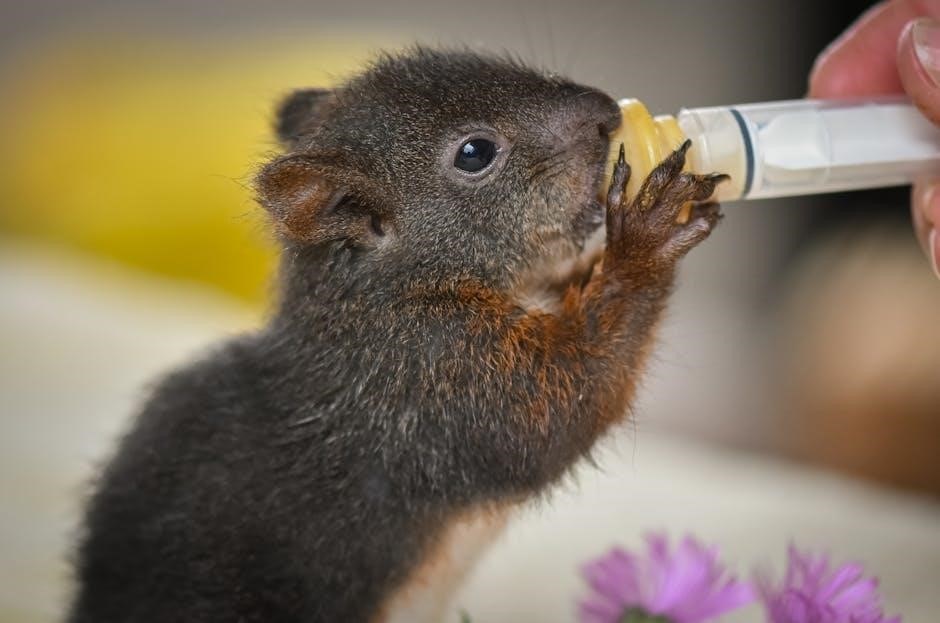
Initial Care and Assessment
Initial care involves assessing the baby squirrel for injuries or dehydration, then providing hydration with Pedialyte and a warm environment for stabilization.
Checking for Injuries or Dehydration
Examine the baby squirrel for visible injuries, shivering, or pale gums, which indicate dehydration. A dehydrated squirrel may also have a dry mouth and sunken eyes. Gently assess for wounds or fractures. If dehydrated, provide unflavored Pedialyte using a syringe, and ensure the environment is warm to stabilize the baby’s condition before feeding.
Providing Immediate Warmth and Hydration
Place the baby squirrel near a warm heat source, such as a rice-filled sock heated in the microwave. Administer unflavored Pedialyte using a small syringe to rehydrate. Ensure the liquid is slightly warm to prevent shocking the baby. Avoid feeding until the squirrel is warm and hydrated, as hypothermia can be life-threatening without proper care.
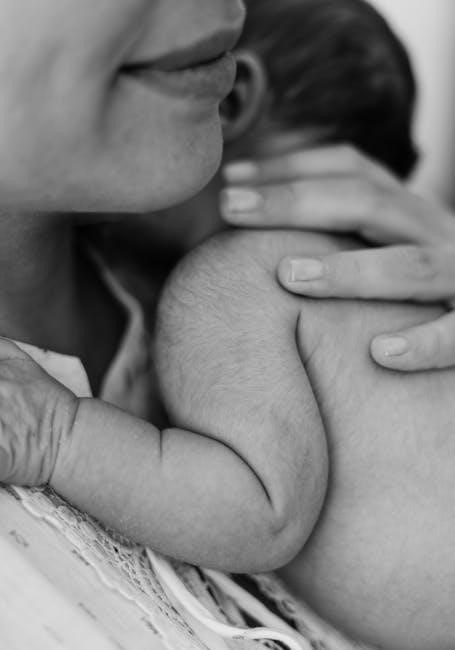
Feeding a Baby Squirrel
Start with unflavored Pedialyte for hydration, then transition to puppy milk replacer. Feed every 2-3 hours, gradually increasing intervals as the squirrel grows and becomes independent.
Hydration First: Using Pedialyte
Hydration is critical for a baby squirrel’s survival. Use unflavored Pedialyte to rehydrate, administered via a small syringe. Ensure the liquid is slightly warm to mimic natural conditions. Proper hydration prevents dehydration and prepares the squirrel for formula feeding. Avoid using cow’s milk, as it can cause harm. Always warm the Pedialyte before administering to the squirrel.
Formula Feeding: Puppy Milk Replacer
After rehydration, introduce puppy milk replacer (e.g., Esbilac) as the primary formula. Feed every 2-3 hours around the clock until the squirrel is two weeks old. Avoid cow’s milk, as it’s harmful. Use a syringe to gently administer the formula, ensuring the squirrel swallows properly. Overfeeding can cause health issues, so monitor intake closely and stop when the squirrel refuses more milk.
Feeding Schedule and Portion Control
Feed baby squirrels every 2-3 hours around the clock until they are two weeks old. Gradually increase the interval as they grow, feeding every 3-4 hours until their eyes open. Portion sizes should match their age and weight, starting with 0.5-1 cc and increasing slowly. Monitor their belly to avoid overfeeding, and stop when they refuse formula to prevent waste and health issues.
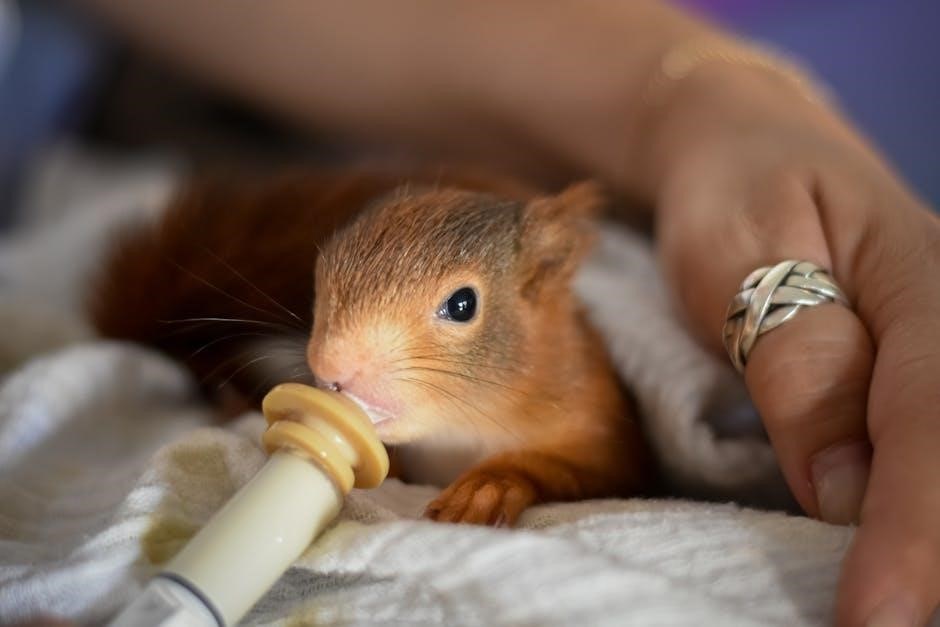
Caring for a Baby Squirrel’s Hygiene
Regularly inspect for parasites like fleas or mites. Use flea combs or tweezers to remove pests. Clean the squirrel with safe, gentle products, and maintain a clean environment daily.
Removing Parasites and Cleaning the Squirrel
Daily inspections are crucial to identify parasites like fleas, mites, or ticks. Use flea combs or tweezers to gently remove pests. For severe cases, use safe, small-animal flea sprays. Clean the squirrel with a damp cloth, avoiding harmful chemicals. Regular cleaning helps prevent infections and keeps the squirrel healthy. Always ensure cleaning products are safe for young animals before use.
Using Safe Cleaning Products
When cleaning a baby squirrel, use mild, unscented soap and lukewarm water. Avoid harsh chemicals, as they can harm the squirrel’s sensitive skin. Gently wipe the fur with a soft cloth, focusing on soiled areas. Rinse thoroughly to remove any soap residue. Ensure all cleaning products are specifically designed for small animals to prevent irritation or toxicity.
Creating a Safe Environment
Provide a warm, cozy space with proper ventilation. Use a plastic box or basket lined with soft fabric, ensuring a safe and comfortable area for the squirrel.
Setting Up a Warm and Cozy Nest
Use a plastic box or basket lined with soft towels or fleece to create a warm nest. Place a hot water bottle wrapped in a towel for heat. Ensure proper ventilation and maintain a comfortable temperature. Keep the nest in a quiet, draft-free area to provide a safe and nurturing environment for the baby squirrel.
Maintaining Proper Temperature and Humidity
Maintain a warm environment with temperatures between 90-100°F for newborns, gradually decreasing as they grow; Use a water bottle or rice sock wrapped in a towel for heat. Ensure proper humidity levels, around 50-60%, using a hygrometer. Monitor the environment to prevent overheating and ensure the baby squirrel stays comfortable and thrives in its setting.
Monitoring Health and Development
Monitor the baby squirrel daily for signs of illness, such as lethargy or labored breathing. Track developmental milestones, like eye opening at four weeks and exploratory behavior.
Recognizing Signs of Illness
Monitor for labored breathing, lethargy, or dehydration. Signs of illness in baby squirrels include refusal to eat, excessive crying, or visible injuries. Check daily for these indicators, as early detection is crucial for successful treatment. Failure to address such issues can lead to severe health complications. Always consult a licensed wildlife rehabilitator if you suspect illness or distress.
Tracking Growth and Developmental Milestones
Monitor the baby squirrel’s progress by tracking weight, activity, and physical changes. Eyes typically open around four weeks, and exploration begins at six weeks. Weaning starts at ten weeks, with full independence by 12 weeks. Regularly observe for signs of healthy growth, such as active behavior and steady weight gain, ensuring proper development and readiness for life in the wild.
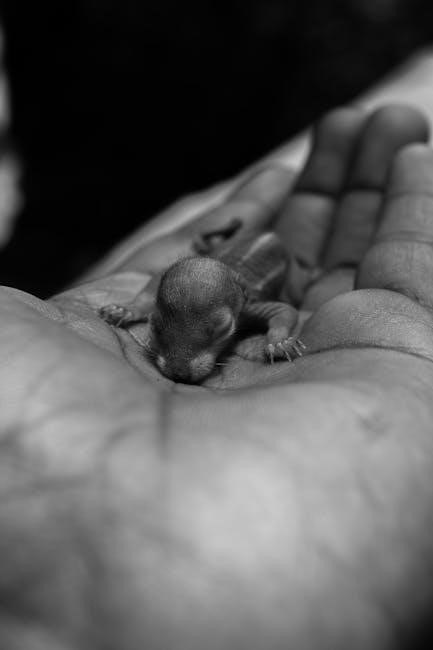
Handling and Interaction
Handle baby squirrels gently, ensuring warmth and security. Wear gloves to prevent transferring your scent. Avoid excessive interaction to mimic natural maternal care and prevent stress.
Best Practices for Handling Baby Squirrels
Handle baby squirrels gently, ensuring their body is fully supported. Wear gloves to prevent transferring your scent, which could deter the mother. Keep interactions brief to avoid stress and mimic natural maternal care. Provide a warm, secure environment, and avoid excessive handling. Feed and care for them on a schedule, maintaining their natural routines. Consult a wildlife rehabilitator if concerns arise.
Encouraging Socialization and Natural Behavior
Encourage socialization by simulating a natural environment. Introduce toys and objects that mimic forest settings. Allow interaction with siblings to promote bonding. Provide nesting materials for comfort and instinctual behavior. Gradually introduce exploration outside the nest. This fosters independence and prepares them for life in the wild, ensuring a smooth transition to their natural habitat.
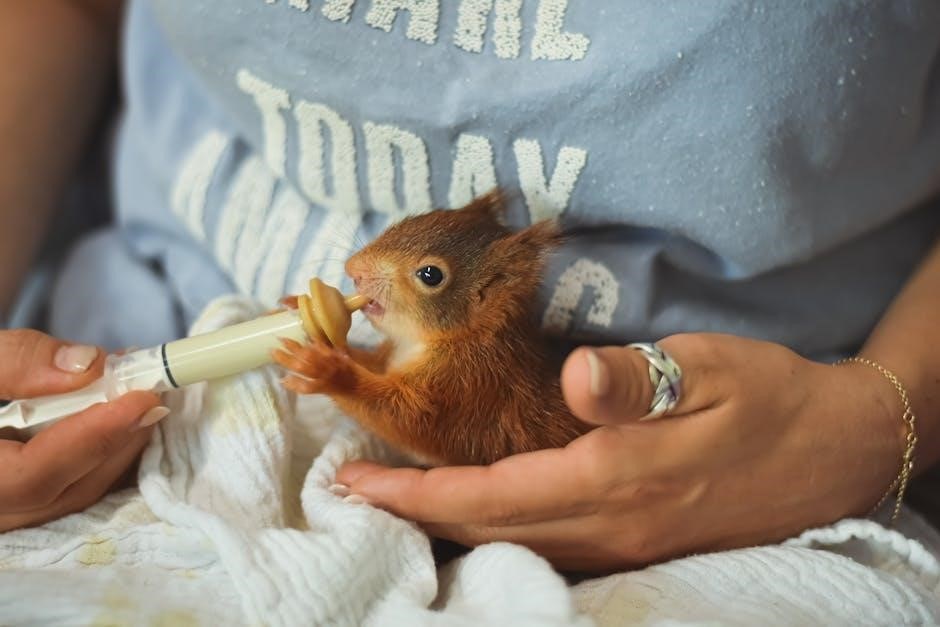
When to Involve a Wildlife Rehabilitator
If a baby squirrel shows signs of severe injury, illness, or inability to feed, seek professional help. Wildlife rehabilitators specialize in providing critical care for orphaned or distressed animals.
Signs That Professional Care Is Needed
If a baby squirrel exhibits severe injuries, labored breathing, or unresponsiveness, professional care is essential. Signs of dehydration, visible bleeding, or seizures also indicate the need for immediate intervention. Improper care can lead to complications or death, making it crucial to contact a licensed wildlife rehabilitator for specialized treatment and the best chance of survival.
Finding a Licensed Wildlife Rehabilitator
To locate a licensed wildlife rehabilitator, contact local animal control, state wildlife agencies, or use online directories. Ensure the rehabilitator is certified and experienced in caring for squirrels. Call hotlines like 269-215-9509 for emergency assistance. Always verify credentials to guarantee professional, life-saving care for the baby squirrel, ensuring the best chance of survival and proper rehabilitation.
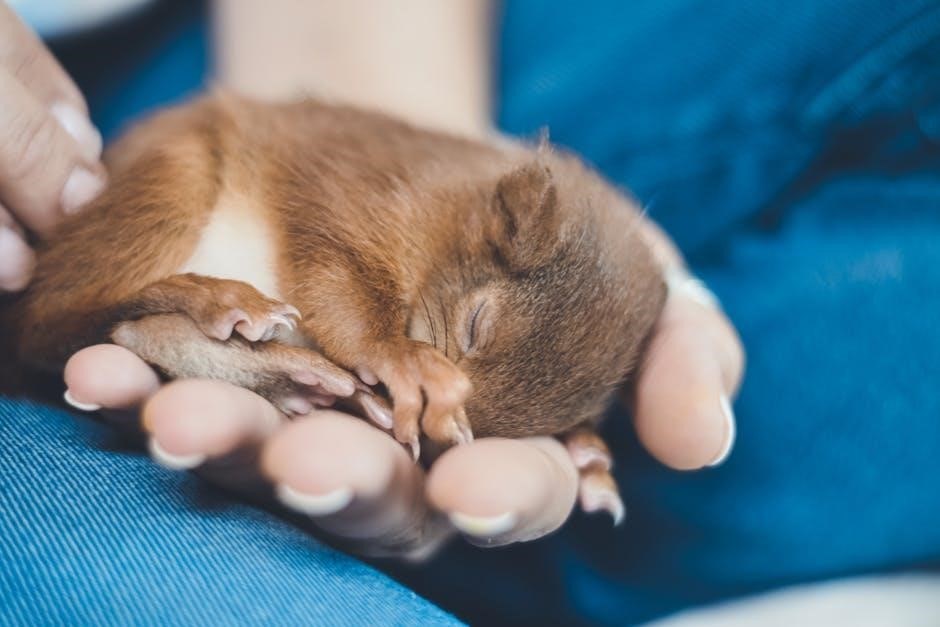
Legal Considerations
Understand local laws and regulations regarding wildlife care. Some areas prohibit raising grey squirrels, and improper care can lead to legal consequences. Always comply with regional guidelines to ensure both legal and ethical standards are met when caring for baby squirrels.
Understanding Local Laws and Regulations
Research and comply with local wildlife laws, as raising baby squirrels may require permits. Some regions prohibit caring for certain species, like grey squirrels. Violations can lead to legal penalties. Ensure you understand regulations regarding capture, care, and release to avoid conflicts with authorities. This ensures ethical and lawful wildlife care practices.
Importance of Releasing Squirrels in the Right Area
Releasing baby squirrels in their native habitat ensures their survival by familiarizing them with local food sources and predators. Returning them to the area they were found maintains genetic diversity and ecological balance. Incorrect release locations can lead to maladjustment and reduced chances of thriving in the wild, emphasizing the need for precise re-release strategies.
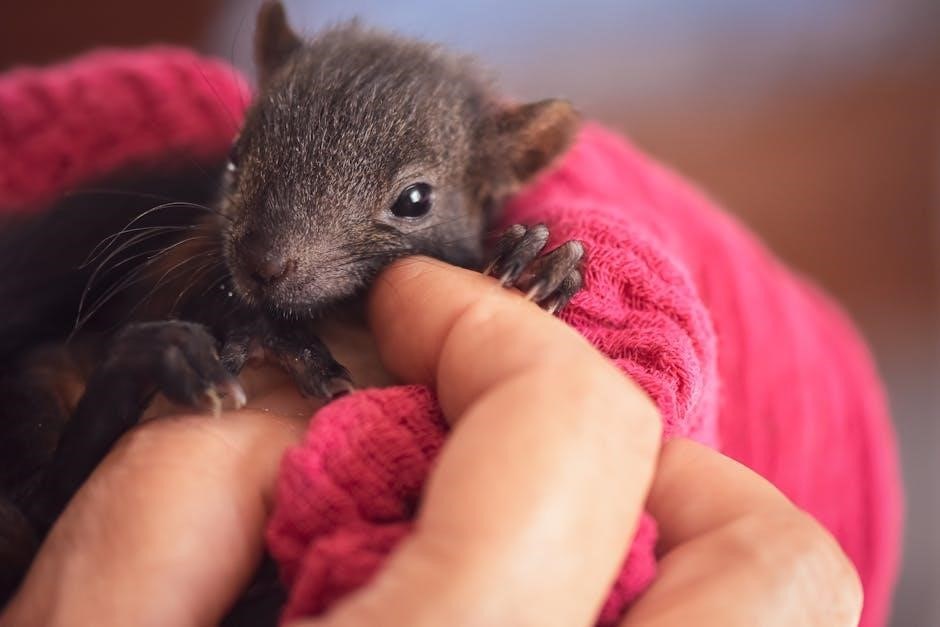
Baby Squirrel Developmental Stages
Baby squirrels develop rapidly, with critical milestones including eye opening at four weeks and exploring outside the nest by six weeks, leading to full independence by twelve weeks.
Eye Opening and Exploratory Behavior
At around four weeks, baby squirrels’ eyes begin to open, marking the start of their exploratory phase. They gradually gain curiosity, venturing out of their nest by six weeks. This period is crucial for motor skill development and adaptation to their surroundings, ensuring they become adept at navigating their environment as they grow.
Weaning and Independence Timeline
Baby squirrels typically begin weaning at 10 weeks, becoming fully independent by 12 weeks. During this phase, they transition from milk to solid foods and develop essential survival skills. Proper care during weaning is crucial to ensure a smooth transition to independence, preparing them for life in the wild.
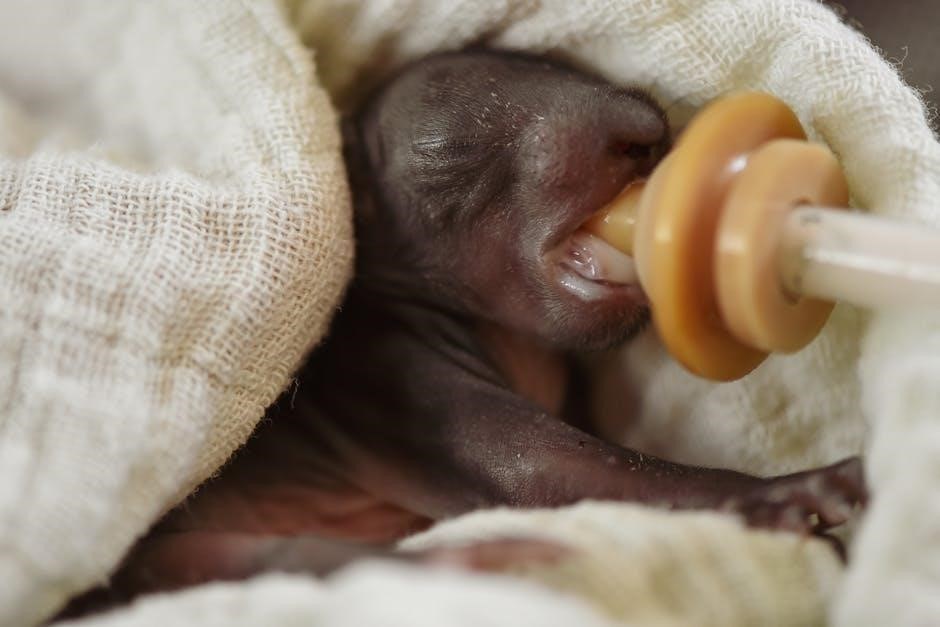
Reintroducing to the Wild
Releasing a baby squirrel into its natural habitat requires careful preparation, ensuring it is healthy and ready for independence. Choose the right location for a successful transition.
Preparation for Release
Before releasing a baby squirrel, ensure it is fully weaned, exhibits natural behaviors, and is free from health issues. Choose a safe, familiar location with ample food and shelter. Acclimate the squirrel to outdoor conditions gradually, starting with a secure, escape-proof enclosure. Release when the squirrel is confident and self-sufficient, typically around 12 weeks of age.
Post-Release Care and Support
Monitor the released squirrel from a distance to ensure it adapts well to its environment. Provide supplemental food, like nuts or seeds, in a safe location. Avoid direct interaction to prevent dependency. Observe for signs of distress or illness, and seek professional help if necessary. Ensure the release area remains safe and free from hazards for the squirrel’s well-being.

Caring for Baby Squirrels Long-Term
Ensure continued nutrition and support as the squirrel grows. Create a safe outdoor environment with proper feeding and shelter to promote healthy development and independence over time.
Continued Nutrition and Support
As the baby squirrel grows, feeding schedules adjust to meet increasing nutritional needs. Transition from formula to solid foods gradually, introducing nuts, seeds, and fruits. Ensure a balanced diet rich in essential nutrients to support energy and development. Proper nutrition is crucial for healthy growth and preparing the squirrel for independence.
Creating a Safe Outdoor Environment
Provide a secure, predator-free outdoor space with adequate shelter and nesting material. Ensure the area is escape-proof and protected from harsh weather. Introduce natural elements like trees or climbing structures to simulate their wild habitat. Monitor the squirrel’s adaptation and ensure access to fresh water and food sources. This environment aids in preparing the squirrel for eventual release into the wild.
Specialized Care Techniques
Stimulate waste elimination through gentle massages and warm water baths. Monitor temperature closely to prevent hypothermia, ensuring the squirrel feels warmer than human skin. Promote healthy development.
Stimulating Waste Elimination
Gently massage the baby squirrel’s genital and anal areas with a warm, damp cloth or Q-tip to encourage urination and defecation. This mimics the mother’s natural stimulation. Dip the squirrel in warm water up to its armpits before feeding to aid elimination. Always ensure the squirrel is warm, as hypothermia can hinder digestion. This technique prevents complications like aspiration pneumonia and promotes healthy bowel movements.
Recognizing and Preventing Hypothermia
A baby squirrel should feel warmer than your skin; if it feels cool, it may be hypothermic. To prevent this, place a warm rice sock or heated water bottle near the squirrel. Ensure the environment is draft-free and maintain a consistent temperature. Never feed a cold squirrel, as hypothermia can be fatal. Warmth is critical for proper digestion and overall health.
Knowing When to Stop Care
Stop care when the baby squirrel is fully weaned, active, and exhibits independent behavior, typically around 12 weeks of age. Release when ready for survival.
Recognizing Readiness for Independence
A baby squirrel is ready for independence when it can forage, climb, and demonstrate natural behaviors without human assistance. This typically occurs around 10-12 weeks, when they are fully weaned and exhibit curiosity and self-reliance, indicating they can thrive on their own in the wild.
Ensuring a Successful Transition
A successful transition involves gradually introducing the baby squirrel to its natural habitat. Start with a controlled outdoor enclosure to acclimate it to environmental stimuli. Provide food and shelter while allowing it to explore and practice survival skills. Release when it exhibits confident foraging and climbing abilities, ensuring a smooth adaptation to wild life.
Emergency Contacts and Resources
For urgent assistance, call the hotline at 269-215-9509. Additional support is available through online forums and wildlife rehabilitator networks for expert advice and guidance.
Hotlines for Squirrel Emergency Help
For immediate assistance with a baby squirrel, call the dedicated hotline at 269-215-9509. This service provides real-time advice and connects you with licensed wildlife experts. Additionally, online forums and wildlife rehabilitator networks offer further support, ensuring you receive the help needed to care for your baby squirrel effectively and safely.
Online Communities and Support Groups
Online forums and support groups, such as Reddit communities and Facebook groups, offer valuable resources and real-time advice for baby squirrel care. These platforms connect you with experienced caretakers and wildlife experts, providing shared knowledge, tips, and emotional support. They also host discussions on feeding, health, and rehabilitation, making them indispensable for ensuring the best care for your baby squirrel.
